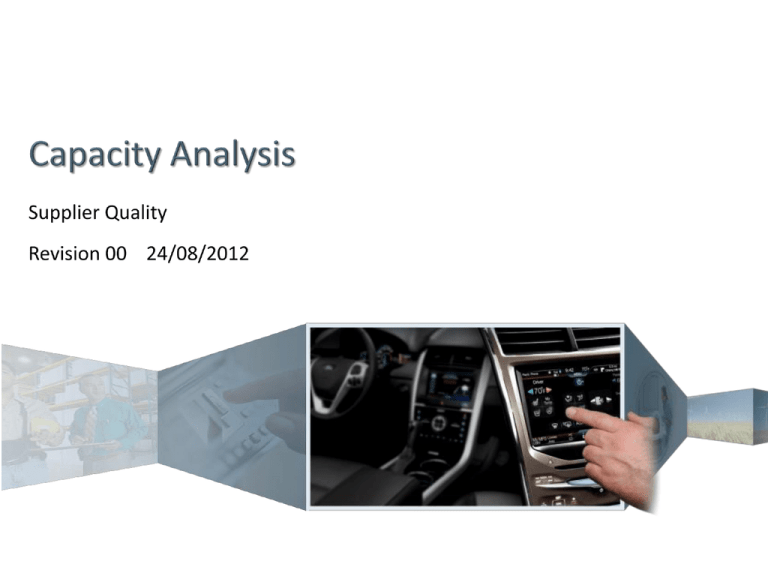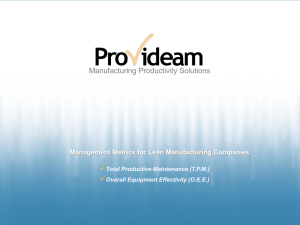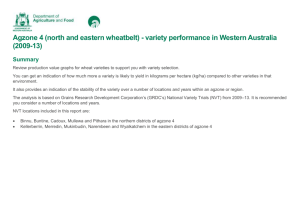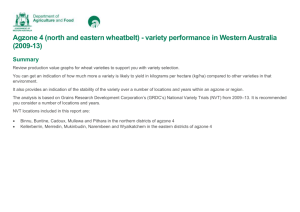
Capacity Analysis
A. New Model Required OEE A1) Supplier & Part Information
Supplier Name
Location/Site Code
Part Name
Part Number
•
•
Fill in Supplier Name and Supplier Location (Address)
Fill in Part Name (Ex: Bush, Button, Housing…….refer to drawing)
•
Fill in Part Number (If the study is on a group of parts no. of parts together list all part
nos.)
A2) Capacity Requirements
Date of Study
APW
MPW
<PA> Requirements
Revised Requirements
•
Fill in Date when Capacity Analysis Exercise was conducted
•
APW stands for Average Production Weekly. This is the average weekly quantity of
parts specified by Methode. This means that if requirements are 2,000 per week in the
first month and 4,000 per week when production peaks, the APW shall be 3,000.
•
MPW stands for Maximum Production Weekly. This is the maximum no. of parts/ week
specified by Methode.
2
Confidential - All Rights Reserved - © 2012
Capacity Analysis
A3) Key Contacts
Name
Phone #
Email
Supplier Contact
Methode STA
•
Fill in Supplier Contact person details
A4) Planned Departmental Operating
Pattern & Net Available Time
A
B
C
D
E
F
G
G1
G2
Process description (in value stream order)
Days / Week
Shifts / Day
Total Hours / Shift
Contractual Planned Downtime - lunch, breaks, etc.
Allocation Percent (enter 100 for dedicated)
Net Available Time (hours / week) [B*C*(D-(E/60))*F]
Planned Minutes per Changeover (into this part #)
Planned Changeover Frequency / Week (into this part #)
•
Process 1
Process 2
Process 3
APW Plan
MPW Plan
APW Plan
MPW Plan
APW Plan
MPW Plan
-
-
-
-
-
-
Sheet shall be tackled taking one process at a time.
That is if supplied part is a laser etched painted plastic button, there are three processes
which are plastic injection moulding, painting and laser etching.
If a part is machined and then plated, a typical process shall be blanking, polish of drawn
material outer profile, drilling, roughing, internal diameter of one side (roughing and
finishing), Outer finishing, second side internal and external diameters, plating and 100%
check.
3
Confidential - All Rights Reserved - © 2012
Capacity Analysis
A4) Planned Departmental Operating
Pattern & Net Available Time
A
B
C
D
E
F
G
G1
G2
•
•
•
•
•
•
Process description (in value stream order)
Days / Week
Shifts / Day
Total Hours / Shift
Contractual Planned Downtime - lunch, breaks, etc.
Allocation Percent (enter 100 for dedicated)
Net Available Time (hours / week) [B*C*(D-(E/60))*F]
Planned Minutes per Changeover (into this part #)
Planned Changeover Frequency / Week (into this part #)
Process 1
Process 2
Process 3
APW Plan
MPW Plan
APW Plan
MPW Plan
APW Plan
MPW Plan
-
-
-
-
-
-
Fill in Process Name
How many days per week is the process running?
How many shifts is the process doing per day?
How long is the shift (in hours)? Example if shift starts at 6.00 and ends at 14.00, duration is
8 hours.
What amount of time is the process stopped for breaks, preventive maintenance, cleaning,
handover, lunch, etc. (PER SHIFT)? Time should be in minutes. If machine is not stopped
during break/ lunch, then the break/ lunch time shall not be considered in this calculation.
Is the process used only on the product on which the capacity analysis is being carried out?
If yes input 100%. If the process is shared with other products please enter the percentage
allocated for this product. Example: if besides this product, there are another 6 products
that are taking 20 hours of a 24 day, then time available for this product is 4 hrs out of 24hrs
which results in 16.6%.
4
Capacity Analysis
A4) Planned Departmental Operating
Pattern & Net Available Time
A
B
C
D
E
F
G
G1
G2
Process description (in value stream order)
Days / Week
Shifts / Day
Total Hours / Shift
Contractual Planned Downtime - lunch, breaks, etc.
Allocation Percent (enter 100 for dedicated)
Net Available Time (hours / week) [B*C*(D-(E/60))*F]
Planned Minutes per Changeover (into this part #)
Planned Changeover Frequency / Week (into this part #)
Process 1
Process 2
Process 3
APW Plan
MPW Plan
APW Plan
MPW Plan
APW Plan
MPW Plan
-
-
-
-
-
-
•
If the process is shared with other components then there should be a changeover time in
the highlighted field. Changeover is the time needed (in minutes) to switch off from process
A and switch on process B. This could include material change, tool change, cutter change,
etc. – depending on the process. If changeover time is inconsistent, take worst case
scenario. Example if changeover time on process A is 15 minutes and change over time on
process B is 30 minutes – take 30 minutes into equation.
•
How many changeovers are carried out per week? The number of changeovers may vary
from week to week. In such case please take the maximum. Keep in mind that the scope of
the capacity analysis is to understand if with current process and existing equipment, the
supplier is able to supply enough components as requested by the customer.
5
Capacity Analysis
A5) Required Good Parts / Week
H
J
Percent of parts scrapped
Req'd Good Parts / Week to Support Next Process
[Process 1 Req'd Parts = Process 2 Req'd Parts /
Avg. Weekly Max Weekly
(100% - Process 2 Scrap%)]
Required Incoming Parts for
•
-
APW Plan
MPW Plan
APW Plan
MPW Plan
APW Plan
MPW Plan
-
-
-
-
-
-
-
From experience, how much parts are rejected during this process?
6
Capacity Analysis
A6) Required OEE
K
L
M
N
P
Ideal Cycle Time per Tool or Machine (sec/cycle)
# of Tools or Machines in parallel
# of identical parts produced per Tool or Machine Cycle
Net Ideal Cycle Time (sec/part) [K / (L*M)]
Theoretical Parts per week at 100% OEE [G x 3600 / N]
Q
Required OEE
R
S
Percent of parts reworked (re-run through process)
Can process contain its changeover, scrap & rework
assumptions? [Is J/(100%-H) + (JxR) + (G1x60xG2/N) <= P]
% Remaining for Availability & Performance Efficiency
losses {P - [(J/(100%-H)) + (JxR) + (G1x60xG2/N)]} / P
T
[J / P]
APW Plan
MPW Plan
APW Plan
MPW Plan
APW Plan
MPW Plan
-
-
-
-
-
-
-
-
-
-
-
-
-
-
-
-
-
-
-
-
-
-
-
-
-
-
-
-
-
-
Enter any other assumptions for clarification
•
•
•
•
•
What is the ideal cycle time (in seconds) for this process? If the capacity analysis is
preliminary (theoretical), please calculate this time from your experience.
How many tools are available – doing the same process? In case of machining, how many
machines can be used to produce similar parts at the same time?
How many parts are produced in one cycle (in the cycle time period specified above)? For
example, if the process in question is injection moulding from a four cavity tool, then the
value to insert in the table above shall be 4.
Unless approved by Methode, rework is not acceptable. However if this is the case, input the
no. of parts that are recuperated from rejects by re-working.
Include any remarks that will help the receiver to understand if something is not clear.
7
Capacity Analysis
B. Supplier Demonstrated OEE - Phase 3 PPAP (Capacity Verification)
B1) Equipment Availability
V
Total Available Time (Include ACTUAL changeover time for
Shared) (minutes)
Planned Downtime - lunches/breaks/mtgs. (minutes)
Net Available Time (minutes) [V - W]
Shared Equip Changeover Time ACTUAL (minutes)
Shared Equip Changeover Time Weekly Scaled (minutes)
[Y * (X / 60) / (G / G2)]
Observed Unplanned Downtime (minutes)
Operating Time (minutes) [X - Y - AB]
W
X
Y
Z
AB
AC
AD
Equipment Availability [(X - Z - AB) / X * 100]
-
-
-
-
-
-
-
-
-
-
-
-
-
-
-
•
This is the second part of the study – Section B – which is looking at actual facts. Supplier is
requested to carry out a production representative run. Duration of run depends on the
product and is to be discussed case by case between Methode and Supplier.
•
How long is the run in minutes? If there is a changeover planned during OEE run DO NOT
deduct the changeover time. Example if run starts at 10.00 and stops at 14.00, the value to be
input in highlighted field is 360minutes (6hrs x 60 minutes). Some customers specifically ask
for a changeover to be inserted in the OEE – this shall be discussed with Methode.
Was the process stopped for breaks, meetings or any planned activity? If yes, please include
the no. of minutes in which the process was stopped. If process was working during an
operator break, this is not considered as planned downtime…..as the process was not
stopped.
•
8
Capacity Analysis
B. Supplier Demonstrated OEE - Phase 3 PPAP (Capacity Verification)
B1) Equipment Availability
V
Total Available Time (Include ACTUAL changeover time for
Shared) (minutes)
Planned Downtime - lunches/breaks/mtgs. (minutes)
Net Available Time (minutes) [V - W]
Shared Equip Changeover Time ACTUAL (minutes)
Shared Equip Changeover Time Weekly Scaled (minutes)
[Y * (X / 60) / (G / G2)]
Observed Unplanned Downtime (minutes)
Operating Time (minutes) [X - Y - AB]
W
X
Y
Z
AB
AC
AD
Equipment Availability [(X - Z - AB) / X * 100]
-
-
-
-
-
-
-
-
-
-
-
-
-
-
-
•
If there was a change over planned in the run please insert the actual time (in minutes) taken
for the changeover to take place. It is important that the change over activity is given the
same importance as a normal changeover during production. If during production, there are
two persons changing a tool, then during this run, the same two persons shall be do the job.
•
Collect any unplanned downtime that takes place during the run and insert this in the
highlighted field. This may include breakdown maintenance, power cuts, quality issues that
need intervention on process, etc.
9
Capacity Analysis
B2) Performance Efficiency
AE
AF
AG
AH
•
Total Parts Run (Good, Scrapped, & Reworked)
Net Ideal Cycle Time (seconds/part) [N]
17.5
0.6
-
Performance Efficiency (AE * AF / AC)
-
-
-
"Availability" and/or "Performance Efficiency" Losses Not
Captured (minutes) [AC - (AE * AF)]
-
-
-
Insert the total no. of parts produced during the run. Include both good, and bad quality
parts.
B3) Quality Rate
AJ
AK
AL
•
•
#
%
%
-
# Parts Scrapped
# Parts Reworked
Quality Rate [(AE - AJ - AK) / AE]
#
-
#
%
-
-
-
-
Insert the total no. of parts that were detected as not in order and were scrapped.
Insert the total no. of parts that were detected as not in order but these were reworked and
can now be used for production.
B6) Observed Average Cycle Time (sec/cycle)
•
Insert the actual cycle time (seconds) taken for one cycle. If it is recorded on the machine,
the average of a sample of readings taken through out the production run can be inserted in
the highlighted area. If this is not recorded automatically, the cycle time shall be taken by the
use of a stop watch. In this case one has to measure timing every half an hour and take the
average reading.
10
Capacity Analysis – Result Area
C. Gap Analysis - Required OEE vs. Demonstrated OEE; Predicted Good Parts / Week
Process Description
Moulding
Chrome plating
APW Result MPW Result APW Result MPW Result APW Result MPW Result
Demonstrated OEE > Required OEE? (Is AM > Q?)
OK
RISK
OK
RISK
•
Section C is giving a picture of the capacity study.
•
Highlighted fields show if the actual OEE is good enough to fulfil customer Average and
Maximum requirements. If field is marked as OK, the result is satisfactory and no actions are
needed. If field is marked as RISK, then actions need to be taken on that particular process.
Actions may vary from processing parameters, addition of new machines, increasing the no.
of operators, etc. – depending on the process. Whatever the actions taken, these shall be
communicated to the customer in writing together with target dates. Once actions are in
place, capacity analysis shall be repeated.
•
11
The results are also pictured in a graph that
demonstrates the actual gaps where action is
needed.
If in doubt, please ask Methode
Supplier Quality for assistance.










